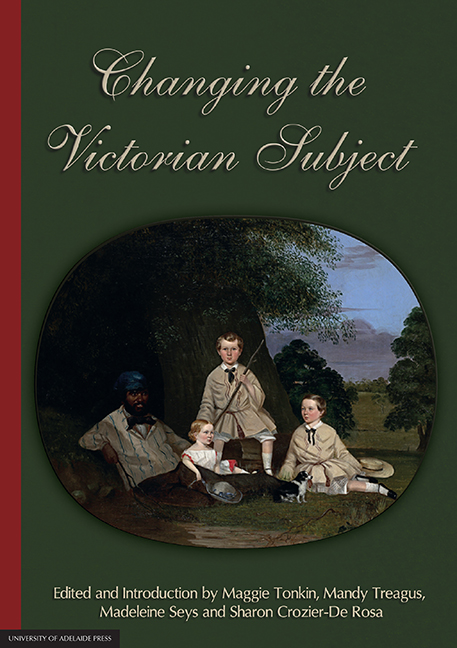Book contents
- Frontmatter
- Contents
- Notes on Contributors
- 1 Re-visiting the Victorian subject
- 2 Queen Victoria's Aboriginal subjects: a late colonial Australian case study
- 3 Identifying with the frontier: Federation New Woman, Nation and Empire
- 4 A ‘Tigress’ in the Paradise of Dissent: Kooroona critiques the foundational colonial story
- 5 The making of Barbara Baynton
- 6 A literary fortune
- 7 Olive Schreiner's From Man to Man and ‘the copy within’
- 8 Guy Boothby's ‘Bid for Fortune’: constructing an Anglo-Australian colonial identity for the fin-de-siècle London literary marketplace
- 9 The scenery and dresses of her dreams: reading and reflecting (on) the Victorian heroine in M.E. Braddon's The Doctor's Wife
- 10 The woman artist and narrative ends in late-Victorian writing
- 11 Miss Wade's torment: the perverse construction of same-sex desire in Little Dorrit
- 12 ‘All the world is blind’: unveiling same-sex desire in the poetry of Amy Levy
- 13 From ‘Peter Panic’ to proto-Modernism: the case of J.M. Barrie
11 - Miss Wade's torment: the perverse construction of same-sex desire in Little Dorrit
Published online by Cambridge University Press: 05 December 2014
- Frontmatter
- Contents
- Notes on Contributors
- 1 Re-visiting the Victorian subject
- 2 Queen Victoria's Aboriginal subjects: a late colonial Australian case study
- 3 Identifying with the frontier: Federation New Woman, Nation and Empire
- 4 A ‘Tigress’ in the Paradise of Dissent: Kooroona critiques the foundational colonial story
- 5 The making of Barbara Baynton
- 6 A literary fortune
- 7 Olive Schreiner's From Man to Man and ‘the copy within’
- 8 Guy Boothby's ‘Bid for Fortune’: constructing an Anglo-Australian colonial identity for the fin-de-siècle London literary marketplace
- 9 The scenery and dresses of her dreams: reading and reflecting (on) the Victorian heroine in M.E. Braddon's The Doctor's Wife
- 10 The woman artist and narrative ends in late-Victorian writing
- 11 Miss Wade's torment: the perverse construction of same-sex desire in Little Dorrit
- 12 ‘All the world is blind’: unveiling same-sex desire in the poetry of Amy Levy
- 13 From ‘Peter Panic’ to proto-Modernism: the case of J.M. Barrie
Summary
The title of this chapter seeks in a ‘tongue in cheek’ way to wrest Miss Wade's torment away from its familiar self-imposed shackles to a torment that is at least in part connected to frustration with her less than sympathetic creator. This is a small step but one that is nonetheless significant because perhaps of all Charles Dickens's characters, Miss Wade, from the serial novel Little Dorrit, has been locked up for far too long in walls that are thought to be entirely of her own making. Certainly, Miss Wade does offer up her confessional text ‘The History of a Self-Tormentor’ to a male auditor and this unfortunate piece of writing very conveniently gives readers the permission to dismiss her as a highly disturbed self-saboteur. But Miss Wade is not simply hoist by her own petard — her creator has had an active hand in making the poor quality fuse for the petard. So, whilst it may be ‘a commonplace in criticism’ (Barrett 200) to note that the primary metaphor of Little Dorrit is the prison, it is far from commonplace to note that Miss Wade's particular blend of psychological imprisonment owes as much to her own distorted views as to Dickens's wish to figuratively lock her up and throw away the key.
- Type
- Chapter
- Information
- Changing the Victorian Subject , pp. 217 - 240Publisher: The University of Adelaide PressPrint publication year: 2014



